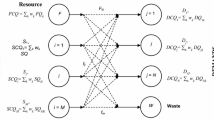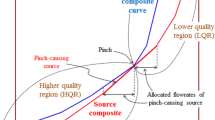Abstract
Pinch analysis is a well-established technique to achieve sustainable development through conservation of various resources. The techniques of pinch analysis are also applied for cost minimisation in several problems as cost-effectiveness plays a major role in decision making for any industry. In this paper, cost optimality of a special kind of resource allocation problem, called segregated targeting problem with dedicated sources, is addressed. A segregated targeting problem consists of multiple set of demands called zones and a set of common internal sources. Dedicated sources are the internal sources which are specific to a zone in which they are present and are not shared with other zones. A mathematically rigorous methodology is developed in this paper and a quantity with the dimension of per unit cost that sets the preference for the distribution of flow from different sources to demands is identified. The applicability of the proposed methodology is demonstrated through three illustrative examples from diverse domains: carbon constrained energy sector planning, water allocation network, and integrated iron and steel mill.






Similar content being viewed by others
Abbreviations
- C :
-
Cost (billion $, $/h, $/year)
- c rk :
-
Per unit cost of resource present in kth zone ($/MJ, $/t, $/m3)
- F si :
-
Flow of ith internal source (TJ, t/h, million m3/year)
- F djk :
-
Flow of jth demand of kth zone (TJ, t/h, million m3/year)
- F DSlk :
-
Flow of lth dedicated source present in kth zone (TJ, t/h, million m3/year)
- f ijk :
-
Flow transferred from ith source to jth demand of kth zone (TJ, t/h, million m3/year)
- f iw :
-
Flow transferred from ith source to waste (TJ, t/h, million m3/year)
- f ljk :
-
Flow transferred from lth dedicated source to jth demand of kth zone (TJ, t/h, million m3/year)
- f lwk :
-
Flow transferred from lth dedicated source of kth zone to waste (TJ, t/h, million m3/year)
- f rjk :
-
Flow transferred from resource to jth demand of kth zone (TJ, t/h, million m3/year)
- P :
-
Cost-benefit number ($/MJ, $/t, $/m3)
- q DSlk :
-
Quality of lth dedicated source present in kth zone (t/TJ, ppm, mg/L)
- q djk :
-
Quality of jth demand of kth zone (t/TJ, ppm, mg/L)
- q pk :
-
Quality of pinch point of kth zone (t/TJ, ppm, mg/L)
- q rk :
-
Quality of resource at kth zone (t/TJ, ppm, mg/L)
- q si :
-
Quality of ith source (t/TJ, ppm, mg/L)
- q sm :
-
Quality of mth internal source (t/TJ, ppm, mg/L)
- R k :
-
Resource present in kth zone (TJ, t/h, million m3/year)
- R si :
-
Resource required in a zone if ith source is the pinch source (TJ, t/h, million m3/year)
- R p :
-
Actual resource required in a zone (TJ, t/h, million m3/year)
- W :
-
Waste (TJ, t/h, million m3/year)
- δ :
-
Flow transferred from internal source to different zones (TJ, t/h, million m3/year)
- ∆ :
-
Minimum flow transferred from internal source to change the pinch point (TJ, t/h, million m3/year)
- α :
-
Minimum of the flow available in mth internal source and the flow needed for pinch jump (TJ, t/h, million m3/year)
- DS :
-
Dedicated source
- d :
-
Demand
- i,m :
-
Source index
- j :
-
Demand index
- l :
-
Dedicated source index
- k :
-
Resource index
- max :
-
Maximum
- min :
-
Minimum
- p :
-
Pinch point index
- r :
-
Resource indices
- s :
-
Source
- w :
-
Waste
- 1, 2,…, N :
-
indices
References
Alves JJ, Towler GP (2002) Analysis of refinery hydrogen distribution systems. Ind Eng Chem Res 41(23):5759–5769. https://doi.org/10.1021/ie010558v
Bandyopadhyay S (2011) Design and optimization of isolated energy systems through pinch analysis. Asia Pac J Chem Eng 6(3):518–526. https://doi.org/10.1002/apj.551
Bandyopadhyay S (2015) Mathematical foundation of pinch analysis. Chem Eng Trans 45:1753–1758. https://doi.org/10.3303/CET1545293
Bandyopadhyay S, Malik RK, Shenoy UV (1999) Invariant rectifying-stripping curves for targeting minimum energy and feed location in distillation. Comp Chem Eng 23(8):1109–1124. https://doi.org/10.1016/S0098-1354(99)00277-X
Bandyopadhyay S, Varghese J, Bansal V (2010a) Targeting for cogeneration potential through total site integration. Appl Therm Eng 30(1):6–14. https://doi.org/10.1016/j.applthermaleng.2009.03.007
Bandyopadhyay S, Sahu GC, Foo DCY, Tan RR (2010b) Segregated targeting for multiple resource networks using decomposition algorithm. AICHE J 56:1235–1248. https://doi.org/10.1002/aic.12050
Chandrayan A, Bandyopadhyay S (2014) Cost optimal segregated targeting for resource allocation networks. Clean Techn Environ Policy 16(3):455–465. https://doi.org/10.1007/s10098-013-0646-y
Chew IML, Foo DCY (2009) Automated targeting for inter-plant water integration. Chem Eng J 153(1-3):23–36. https://doi.org/10.1016/j.cej.2009.05.026
El-Halwagi MM, Manousiouthakis V (1989) Synthesis of mass exchange networks. AICHE J 35(8):1233–1244. https://doi.org/10.1002/aic.690350802
Foo DCY, Manan ZA (2006) Setting the minimum utility gas flowrate targets using cascade analysis technique. Ind Eng Chem Res 45(17):5986–5995. https://doi.org/10.1021/ie051322k
Foo DCY, Ooi REH, Tan RR, Lee J (2016) Process integration approaches to optimal planning of unconventional gas field development. Chem Eng Sci 150:85–93. https://doi.org/10.1016/j.ces.2016.04.049
Hallale N, Fraser DM (1998) Capital cost targets for mass exchange networks. A special case: water minimisation. Chem Eng Sci 53(2):293–313. https://doi.org/10.1016/S0009-2509(97)00191-7
Jain S, Bandyopadhyay S (2017) Resource allocation network for segregated targeting problems with dedicated sources. Ind Eng Chem Res 56(46):13831–13843. https://doi.org/10.1021/acs.iecr.7b03329
Kazantzi V, El-Halwagi MM (2005) Targeting material reuse via property integration. Chem Eng Prog 101:28–37
Lee SC, Ng DKS, Foo DCY, Tan RR (2009) Extended pinch targeting techniques for carbon-constrained energy sector planning. Appl Energy 86(1):60–67. https://doi.org/10.1016/j.apenergy.2008.04.002
Linnhoff B, Ahmad S (1990) Cost optimum heat exchanger networks-1. Minimum energy and capital using simple models for capital cost. Comput Chem Eng 14(7):729–750. https://doi.org/10.1016/0098-1354(90)87083-2
Linnhoff B, Townsend DW, Boland D, Hewitt GF, Thomas BEA, Guy AR, Marsland RH (1982) User guide on process integration for the efficient use of energy. The institution of Chemical Engineers, Rugby
Krishna Priya GS, Bandyopadhyay S (2017) Multi-objective pinch analysis for power system planning. Appl Energy 202:335–347. https://doi.org/10.1016/j.apenergy.2017.05.137
Roychaudhuri PS, Kazantzi V, Foo DCY, Tan RR, Bandyopadhyay S (2017) Selection of energy conservation projects through financial pinch analysis. Energy 138:602–615. https://doi.org/10.1016/j.energy.2017.07.082
Sahu GC, Bandyopadhyay S (2011) Holistic approach for resource conservation. Chem Eng World 46:104–108
Sharan P, Bandyopadhyay S (2017) Optimal temperature selection for energy integrated multiple-effect evaporator system. Process Integr Optim Sustain 1(3):189–202. https://doi.org/10.1007/s41660-017-0012-3
Shenoy UV, Bandyopadhyay S (2007) Targeting for multiple resources. Ind Eng Chem Res 46(11):3698–3708. https://doi.org/10.1021/ie070055a
Singhvi A, Shenoy UV (2002) Aggregate planning in supply chains by pinch analysis. Chem Eng Res Des 80(6):597–605. https://doi.org/10.1205/026387602760312791
Tan RR, Foo DCY (2007) Pinch analysis approach to carbon-constrained energy sector planning. Energy 32(8):1422–1429. https://doi.org/10.1016/j.energy.2006.09.018
Tan RR, Bandyopadhyay S, Foo DCY, Ng DKS (2015) Prospects for novel pinch analysis application domains in the 21st century. Chem Eng Trans 45:1741–1746. https://doi.org/10.3303/CET1545291
Tan RR, Kamal M, Aziz A, Ng DKS, Foo DCY, Loong H (2016) Pinch analysis-based approach to industrial safety risk and environmental management. Clean Techn Environ Policy 18(7):2107–2117. https://doi.org/10.1007/s10098-016-1101-7
Tan RR, Bandyopadhyay S, Foo DCY (2017) Pinch analysis approach to optimal planning of biochar-based carbon management networks. In: Adv Control Ind Process. Taipei, Taiwan, pp 67–72
Wang YP, Smith R (1994) Wastewater minimisation. Chem Eng Sci 49(7):981–1006. https://doi.org/10.1016/0009-2509(94)80006-5
Zhelev TK, Ntlhakana JL (1999) Energy-environment closed-loop through oxygen pinch. Comput Chem Eng 23:S79–S83. https://doi.org/10.1016/S0098-1354(99)80021-0
Author information
Authors and Affiliations
Corresponding author
Ethics declarations
Conflict of Interest
The authors declare that they have no conflict of interest.
Rights and permissions
About this article
Cite this article
Jain, S., Bandyopadhyay, S. Cost Optimal Segregated Targeting Problems with Dedicated Sources. Process Integr Optim Sustain 2, 143–158 (2018). https://doi.org/10.1007/s41660-017-0028-8
Received:
Revised:
Accepted:
Published:
Issue Date:
DOI: https://doi.org/10.1007/s41660-017-0028-8




